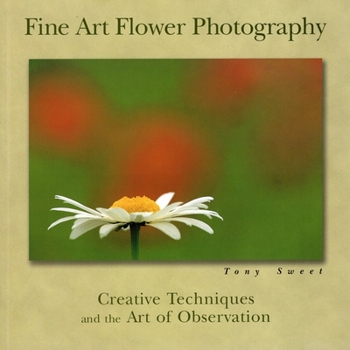Fine Art Flower Photography: Creative Techniques And The Art Of Observation
Select Format
Select Condition 
Book Overview
A striking new collection from the author of Fine Art Nature PhotographyIncludes instructions for creating varied photographic effects Detailed specs and equipment given for each picture with "before" and "after" versions provided for many images
Acclaimed nature photographer Tony Sweet helps us to see a familiar subject through new eyes in this astonishing collection of flower photography. Ranging from the elegiac to the experimental, these pictures offer a kaleidoscopic survey of innovative photographic techniques--including multiple exposures and "slide sandwiching" --along with instructions for creating similar effects in your own photography. Perfectly balancing grace and spontaneity, Fine Art Flower Photography ensures that none of us will look at (or photograph) flowers the same way again.
Format:Paperback
Language:English
ISBN:0811731812
ISBN13:9780811731812
Release Date:January 1
Publisher:Stackpole Books
Length:112 Pages
Weight:1.00 lbs.
Dimensions:0.5" x 8.3" x 8.2"
Customer Reviews
5 ratings
Exquisite, artfully done macro photography
Published by Thriftbooks.com User , 18 years ago
Tony Sweet allows the reader to see the beauty of nature through his eyes. The technical information is useful and allowed me the freedom to try to make photos somewhat close to his...
Beautiful flower images, even more great tips
Published by Thriftbooks.com User , 19 years ago
I read Tony Sweet's Fine Art Nature Photography before I read this book. I was expecting similar tips as in Fine Art Nature Photography. But I was wrong. This book has even more of his fine artistic images of flowers. And I learned more tips from this book than from Fine Art Nature Photography. There are quite some "subtle" tips buried in his writing. I like this book more than Fine Art Nature Photography. Since I gave 4 stars to Fine Art Nature Photography, this book got 5 stars. This book is great for those who enjoy Tony Sweet's artic images and would like to learn the techniques.
A guide on how to see your flower subject through the lens
Published by Thriftbooks.com User , 19 years ago
Nature photographer Tony Sweet has a practiced hand and experienced eye, as demonstrated in the many full-page color photos packed into his instructional Fine Art Flower Photography: Creative Techniques And The Art Of Observation. Here's a guide on how to see your flower subject through the lens - from experimental to traditional - and how to employ a range of photographic techniques to enhance your vision. Descriptions include filters and lenses used, and tips for achieving both similar or take-off results.
Deep Knowledge
Published by Thriftbooks.com User , 19 years ago
I have just spent an evening consuming and consumed by this book. Once again, just like with his first book, I am constantly amazed at how much information and enlightenment Tony Sweet squeezes into every photograph and explanatory text. Do not be fooled by the spareness of the writing. If you are willing to invest your attention and concentration you will learn an astounding amount and find yourself greatly inspired and optimistic about the possibilities of your own photographs.
Beautiful. Insightful. Bravo.
Published by Thriftbooks.com User , 19 years ago
This book made me reconsider some of my fundamental feelings about art and photography. For example it made me consider the distinction between non-representational and abstract art. I realized that non-representational art has no counterpart in the world. Abstract art might have such a counterpart, but it is more concerned with line, form, color and other indicia as such than with the subject itself. I also realized that just because a photograph must start with something in the real world doesn't mean that it can't be abstract and concern itself with indicia rather than the subject. All of this is by way of saying that "Fine Art Flower Photography" is a book of abstract art that starts with real flowers, but which has as its subject line, form and color. And it is a terrific and inspiring book. By using a variety of photographic techniques, Sweet is able to divorce line, form and color from their subject and present them in a pure manner that delights the eye. In fact Sweet was so effective in doing this that he transformed my vision of other abstract art and its value. Sweet accomplishes this task by manipulating depth of field, multiple exposures and camera movement to present us with a view of flowers that we would never see with the unaided eye. And these views are surprisingly striking, evoking deep, non-rational responses in the viewer. I have never believed that aesthetics was simply the province of the beautiful, but these pictures certainly can be used to support such an argument. I've long had a feeling that manipulating a photograph in the camera in a way that one could not see in a peek through the viewfinder was somehow not real art. Sweet makes it clear though that he starts with a visualization of his final image and then takes the steps to make that vision come true, which of course is exactly what all the great photographers have done, and which is certainly a process that leads to art. This book could stand on its own, as a set of beautiful images, but expert photographers will also find valuable lessons here. Sweet's comments are pithy, but for a person who understands the photographic process, they can suggest the technical steps that will allow the photographer to follow in Sweet's footsteps. My question is whether Sweet has set the bar so high that no one can exceed him. But perhaps these same techniques can be applied to other forms of photography to make different statements that are as beautiful. Although Sweet has used film as his medium, digital photographers will be inspired to apply his same techniques, either in camera or in post processing. Bravo.





